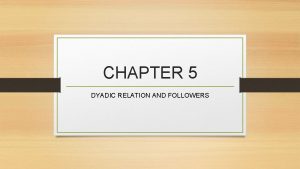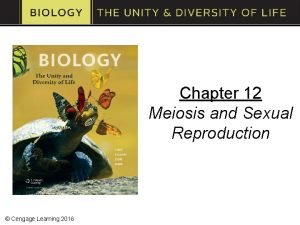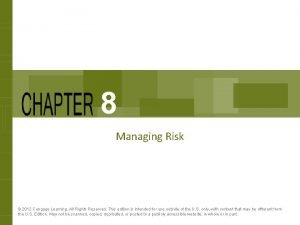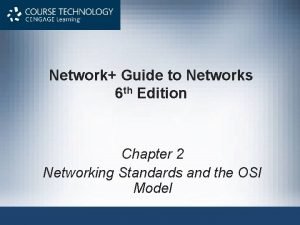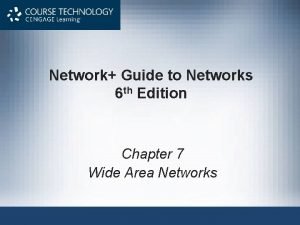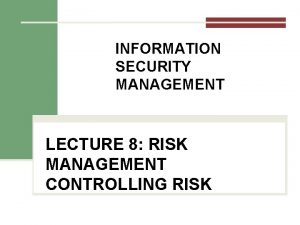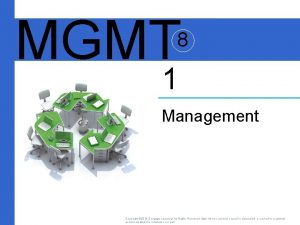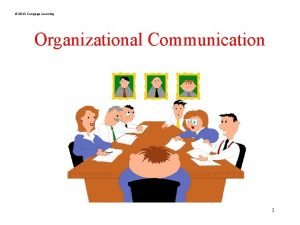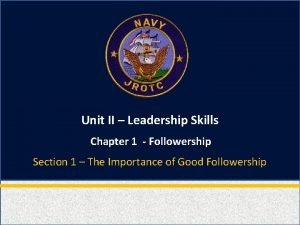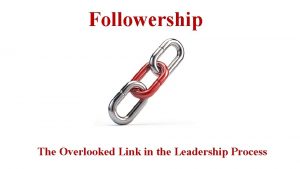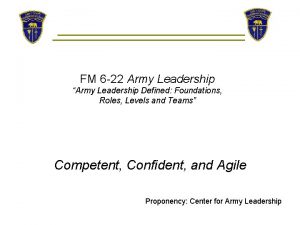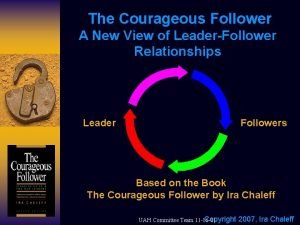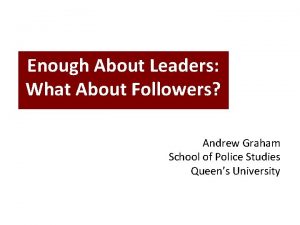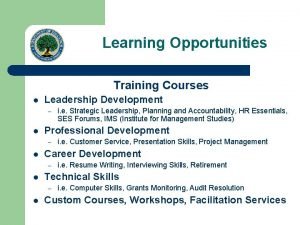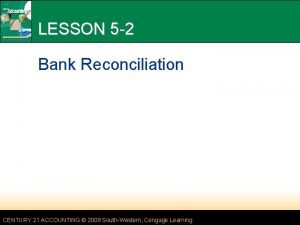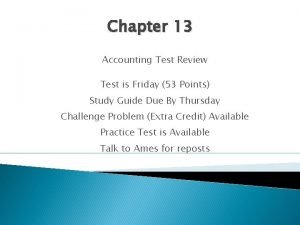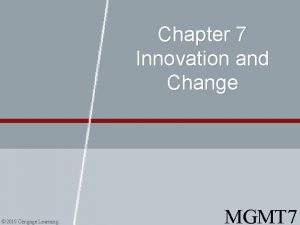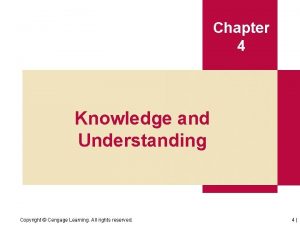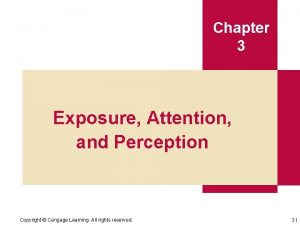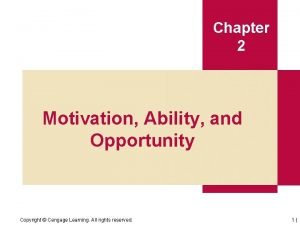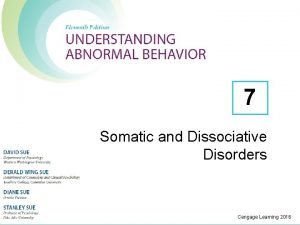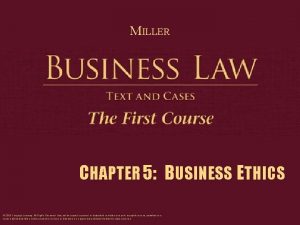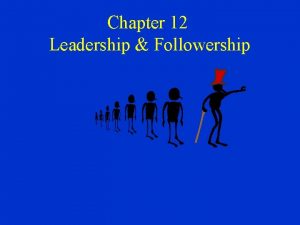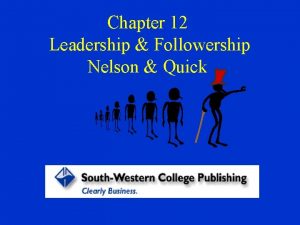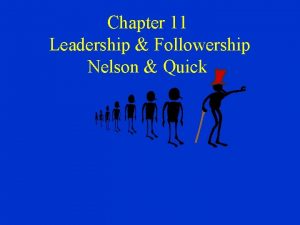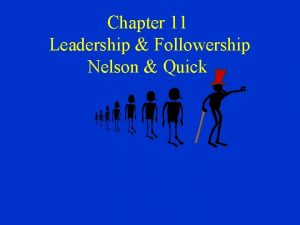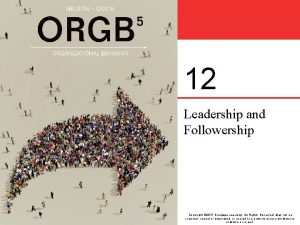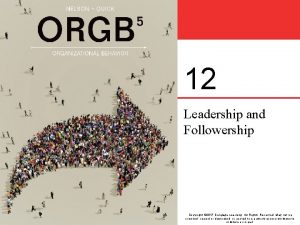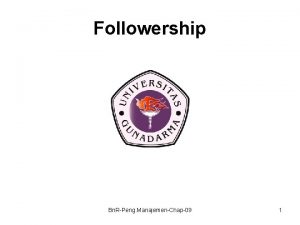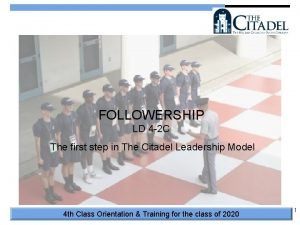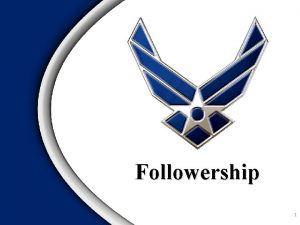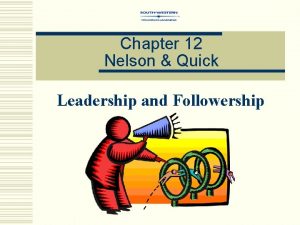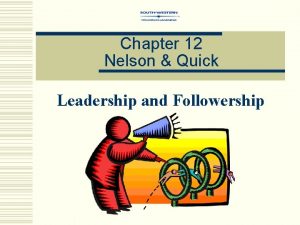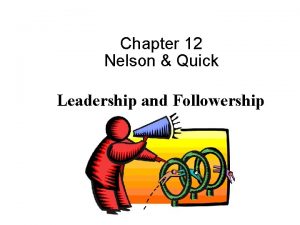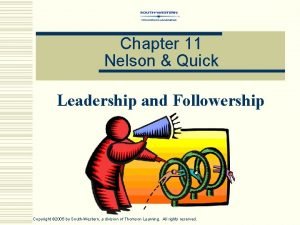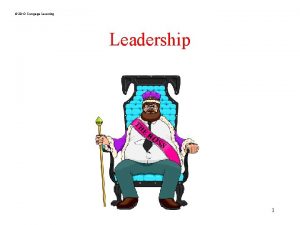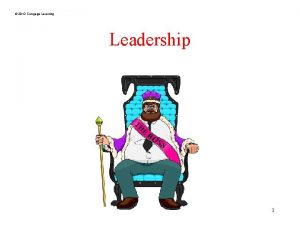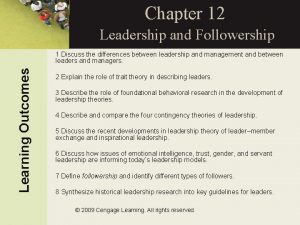12 Leadership and Followership Copyright 2017 Cengage Learning


















































































- Slides: 82

12 Leadership and Followership Copyright © 2017 Cengage Learning. All Rights Reserved. May not be scanned, copied or duplicated, or posted to a publicly accessible website, in whole or in part.

Leadership & Followership Leadership - the process of guiding & directing the behavior of people in the work environment Formal leadership - the officially sanctioned leadership based on the authority of a formal position Informal leadership - the unofficial leadership accorded to a person by other members of the organization Followership - the process of being guided & directed by a leader in the work

Leadership n. An influence relationship among leaders and followers who intend real changes that reflect their shared purpose. (Daft, 2002)

Purpose: the missing factor n. Vision – where we are going n. Mission – who, when, how we will get there n. Values – rules of engagement and norms of behavior n. Purpose – why we do what we do What is the purpose of UNR?

Examples of Purpose n University of Texas Austin: To transform lives for the benefit of society n Mary Kay Cosmetics: Enhancing the lives of women around the world

1 1 6 Fundamental Act of Leadership • The leader’s fundamental act is to induce people to be aware or conscious of what they feel – to feel their true needs so strongly, to define their values so meaningfully, that they can be moved to purposeful action (James Mac. Gregor Burns, Leadership, p. 44). Copyright © 2017 Cengage Learning. All Rights Reserved. May not be scanned, copied or duplicated, or posted to a publicly accessible website, in whole or in part. ORBG 5 | CH 12 6

To manage means “to bring about, to accomplish, to have charge of or responsibility for, to conduct. ” Leading is “influencing, guiding in direction, course, action, opinion. ” The distinction is crucial. Managers are people who do things right and leaders are people who do the right thing. The difference may be summarized as activities of vision and judgment – effectiveness versus activities of mastering routines – efficiency. (Bennis & Nanus, 1997) WSJ Articles: Lt. Withers, Col. Dowdy

Leadership vs. Management To do the right thing, a leader needs to understand what it takes to do things right (Bob Sutton) 8

Action Memo n Leadership is an everyday way of acting and thinking that has little to do with a title or formal position in an organization. n Recognize the opportunities for leadership all around you and act like a leader to influence others and bring about changes for a better future.

Leadership vs. Management Leadership & management are distinct, yet complementary systems of action Effective leadership produces useful change Effective management controls complexity Effective leadership + good management = healthy organizations

Management Process n Reduces uncertainty n Provides stability n Components n Planning & budgeting n Organizing and staffing n Controlling & problem solving Manager – an advocate for stability and the status quo

Leadership Process n Creates uncertainty n Creates change n Components n Setting organizational direction n Aligning people with the Leader – direction via communication an advocate for n Motivating people to action Empowerment n Gratify needs n change and new approaches to problems

Table 12. 1 Leaders and Managers Copyright © 2017 Cengage Learning. All Rights Reserved. May not be scanned, copied or duplicated, or posted to a publicly accessible website, in whole or in part. ORBG 5 | CH 12 13

Trait Theories of Leadership n Attempted to identify what physical attributes, personality characteristics, and abilities distinguished leaders from other members of a group. n Some evidence that leaders are more intelligent, verbal, cooperative, and have higher level of scholarship. n Very few valid generalizations can be made, however.

Copyright © 2017 Cengage Learning. All Rights Reserved. May not be scanned, copied or duplicated, or posted to a publicly accessible website, in whole or in part. ORBG 5 | CH 12 15

Behavioral Theories of Leadership Autocratic Style n A style of leadership in which the leader uses strong, directive, controlling actions to enforce the rules, regulations, activities, and relationships in the work environment. Can have a benevolent dictator. Democratic Style n A style of leadership in which the leader takes collaborative, responsive, interactive actions with followers concerning the work and the work environment.

Leadership Behavioral Theory: Ohio State Studies Initiating Structure – Leader behavior aimed at defining and organizing work relationships and roles; establishing clear patterns of organization, communication, and ways of getting things done. Consideration – Leader behavior aimed at nurturing friendly, warm working relationships, as well as encouraging mutual trust and interpersonal respect within the work unit.

Leadership Behavioral Theory: Michigan Studies Production-Oriented Leader • Constant leader influence • Direct or close supervision • Many written or unwritten rules and regulations • Focus on getting work done Employee-Oriented Leader • Relationship-focused environment • Less direct/close supervision • Fewer written or unwritten rules and regulations • Focus on employee concern and needs

The Leadership Grid

Traits and Behaviors n Derue, D. S. et al. (2011). Trait and behavioral theories of leadership: An integration and meta-analytic test of their relative validity. Personnel Psychology, 64: 7 -52.

Traits and Behaviors n Although having certain traits may predispose individuals to certain behaviors, behaviors are the more important predictor of leadership effectiveness. n Individuals who are high in Conscientiousness and Extraversion are more likely to be evaluated as effective leaders, and individuals high in Conscientiousness and Agreeableness tend to improve the performance of the groups they lead. (pp. 40 -41). Overall, Conscientiousness was the most consistent trait predictor of leadership effectiveness

Traits and Behaviors n Within the behavioral approach, transformational leadership was the most consistent predictor across a variety of effectiveness criteria (p. 37). Effective leaders must plan and schedule work, support and help their followers, and encourage and facilitate change (p. 41). n The largely negative relationship found between passive leadership behavior and effectiveness suggests that even engaging in suboptimal leadership behaviors is better than inaction. Thus, leadership development initiatives should encourage individuals to proactively assume their leadership responsibilities rather than passively

Contingency Theories … involve the belief that leadership style must be appropriate for the particular situation.

Four Contingency Theories 1. 2. 3. 4. Fiedler’s contingency theory Path-goal theory Normative decision theory Situational leadership theory

Fiedler’s Contingency Theory - classifies the favorableness of the leader’s situation Least Preferred Coworker (LPC) - the person a leader has least preferred to work with over his or her career n Task Structure - degree of clarity, or ambiguity, in the group’s work activities n Position Power - authority associated with the leader’s formal position in the organization n Leader-Member Relations – quality of interpersonal relationships among a leader and group members n

Leadership Effectiveness in the Contingency Theory

Fiedler’s theory n Fit between leader’s style (task or relationship) and the situation (favorable or unfavorable) n Both relations and task oriented leaders can be effective in the right situation.

The Situational Leadership ® Model: The Hersey. Blanchard Model © 2008 by South-Western, a division of Cengage Learning

The Path-Goal Theory of Leadership Expectancy Theory of Motivation Contingency

Vroom-Yetton-Jago Normative Decision Model Decide Use the decision method most appropriate for a given decision situation Consult individually Consult group Facilitate Delegate

Leader-Member Exchange Theory In-group Members • Greater responsibilities, more rewards, and more attention • More satisfied, lower turnover • Likely to engage in organizational citizenship behavior • Stress comes from the additional responsibilities Out-group Members • Receive less attention and fewer rewards • Managed by formal rules and policies • Likely to retaliate against the organization • Stress comes from being left out of the communication network Copyright © 2017 Cengage Learning. All Rights Reserved. May not be scanned, copied or duplicated, or posted to a publicly accessible website, in whole or in part. ORBG 5 | CH 12 31

n Build a positive, individualized relationship with each follower rather than treating people as members of an in-group or out-group. n Forge a unique, constructive partnership with each person to create an equitable work environment and provide greater benefits to yourself, followers, and the organization. n Beware of forming in-groups and outgroups. You will often be self- deceived into not believing that they

New Research in Leadership n Transformational Leaders n Leaders who inspire followers to transcend their selfinterests and achieve exceptional performance. n Charismatic Leadership n A leader’s use of personal abilities and talents in order to have profound and extraordinary effects on followers. n Authentic Leader n A leader who is guided by explicit values that emphasize collective interest (shared purpose? ), enabling them to operate at high levels of moral integrity. Not egocentric.

Authentic Leadership n Authentic leaders show to others that they genuinely desire to understand their own leadership to serve others more effectively. n They act in accordance with deep personal values and convictions to build credibility and win the respect and trust of followers. n By encouraging diverse viewpoints and building networks of collaborative relationships with followers, they lead in a manner that followers perceive and describe as authentic.

Figure 12. 6 Five Types of Followers Copyright © 2017 Cengage Learning. All Rights Reserved. May not be scanned, copied or duplicated, or posted to a publicly accessible website, in whole or in part. ORBG 5 | CH 12 35

n. Leaders usually lead as they are led. n. You will probably lead the way that you follow.

Is it OK to offer work related, policy or performance based praise or constructive criticism in the following exchange Praise Manager to an employee, about that employee Manager to other managers, about an employee Manager to other employees, about an employee Manager to other managers, about another manager Manager to her/his employees, about customers or suppliers outside of the organization Employee to other employees, about an employee Employee to a manager, about another employee Employee to a manager, about him/herself Employee to a manager, about the manager Employee to a manager, about other managers Employee to a manager, about customers or suppliers outside of the organization Constructive Criticism

Effective Followers n Effective followers are active, responsible, autonomous in their behavior, and critical in thinking without being disrespectful (? ) or insubordinate (? ) n Effective followers share four essential qualities: n Self-management and self-responsibility. Do not require close supervision. n Other-centered, committed to the organization and its purpose. Not self-centered or selfaggrandizing. n Invest in competence and professionalism (they assume the responsibility to develop themselves) n Courageous, honest, credible n As a follower, you are responsible for your behavior, not the reaction of your leaders and

Loyalty of a follower n Both leaders and followers are entering into a contract to pursue the common purpose within the context of their values. The loyalty of each is to the purpose and to helping each other stay true to that purpose.

Followership (extra) n A willingness to take risks, to challenge authority, and to believe one’s own ideas are equal to or better than one’s superiors typically marks a follower as a future leader (Daft, 2002). n Effective followership requires the courage (Chaleff, 1998): To assume responsibility n To serve n To challenge n To participate in transformation n To take moral action, and possibly even leave n Effective leadership requires the courage to listen to followers n

Courage: The ability to step forward through fear • Courage means accepting responsibility • Courage often means nonconformity • Courage means pushing beyond the comfort zone • Courage means asking for what you want and saying what you think • Courage means fighting for what you believe Whether leading or following, strive to encourage, not discourage, those around you.

Excellence is a form of Deviance n From Robert Quinn’s Deep Change: n Excellence is a form of deviance. If you perform beyond the norms, you will disrupt all the existing control systems. Those systems will then alter and begin to work to routinize your efforts. That is, the systems will adjust and try to make you normal. The way to achieve and maintain excellence is to deviate from the norms. You become excellent because you are doing things normal people do not want to do. You become excellent by choosing a path that is risky and painful, a path that is not appealing to others. (p. 176, emphasis added).

Courageous followership n Courageous followership is built on the foundation of courageous relationship The danger in the leader-follower relationship is the assumption that the leader’s interpretation must dominate n View of hero-leaders/villain leaders vs. view of common person heroes who stay true to their own lights while helping leaders follow theirs. n

Courage of the follower n An individual who is not afraid to speak and act on the truth as she perceives it, despite external inequities, is a force to be reckoned with. n Because courage implies risk, you should develop contingency plans n “Courage muscle” develops to the degree that we exercise it.

Courage to assume responsibility n Assume responsibility for themselves and the organization n Do not hold a paternalistic image of the leader or the organization n Initiate values-based, purposeful action to improve processes n The “authority” to initiate comes from the courageous follower’s understanding and ownership of the common purpose, and from the needs of those the organization serves.

Assume Responsibility Unless and until you assume full responsibility for yourself, you force others to assume responsibility for you.

Courage to serve the leader (look inside yourself first) n Assume new or additional responsibilities to unburden the leader and serve the organization n Stand up for the leader and the tough decisions a leader must make for the org. to achieve its purpose n Are as passionate as the leader in pursuing the common purpose n Stay alert for areas in which their strengths complement the leader’s and assert themselves in these areas.

Courage to challenge n Give voice to the discomfort they feel when the behaviors or policies of the leader or group conflict with their sense of what is right n Willing to stand up, stand out, to risk rejection, to initiate conflict in order to examine the actions of the leader and group when appropriate n Willing to deal with the emotions their challenge evokes in the leader and group n Value organizational harmony, but not at the expense of the common purpose and their integrity

Courage to participate in transformation of the leader n When behavior that jeopardizes the common purpose remains unchanged, courageous followers recognize the need for transformation n Have to examine our own collusion with the leader’s behavior, what we do that allows it to continue. n The leader may be surrounded with advisors who have a strong vested interest in the leader not changing the status quo that is lining their pockets. They may attack the follower who is championing change. n Examine our own need for transformation and become full participants in the change process

Courage to take moral action n Know when it is time to take a stand that is different than that of the leader’s. They answer to a higher set of values. n Taking a stand may involve refusing to obey a direct order, appealing to the next level of authority, or tendering one’s own resignation n These and other forms of moral action involve personal risk, but service to the common purpose justifies and sometimes demands acting.

Followership style n Resource: low support, low challenge n Present, uncommitted, executes minimum requirements, makes complaints to third parties, avoids the attention of authority. n Individualist: low support, high challenge n Confrontational, self-assured, independent thinker, self-marginalizing, unintimidated by authority n Implementer: high support, low challenge n Dependable, supportive, defender, team oriented, compliant, respectful of authority n Partner: high support, high challenge n Risk taker, purpose driven, holds self and others accountable, confronts sensitive issues, peer relations with authority

n Partner followers don’t “dump” on leaders n “This sucks (and so do you) and YOU need to fix it. What’s wrong with you? ” n Partner followers challenge the leader, but also try to share responsibility with the leader for correcting the situation n “This does not seem to be working and I think we can do better. Have you considered these alternatives/options? Here is what I would be willing to do to help. ”

n Effective followers think for themselves and carry out assignments with energy and enthusiasm. They are committed to something outside their own self-interest, and they have the courage to stand up for what they believe. Good followers are not “yes people” who blindly follow a leader (Daft, 2002)

n. At its best, leadership is shared among leaders and followers, with everyone fully engaged and accepting higher levels of responsibility and accountability to each other (Daft, 2002)

Followers and leaders both orbit around the purpose, followers do not orbit around the leader. But if the purpose is not clear and motivating, leaders and followers can only pursue their perceived self-interest, not their common interest.

Authoritarian Manager Participative Manager Stewardship. Empowering leader Servant Leader

Stewardship n Relationship between leaders and followers in which leaders lead without dominating or controlling followers. Stewardship is an employee-focused form of leadership that enables followers to make decisions and have control over their jobs. (Lussier & Achua, 2002)

Service-Profit Chain Operating Strategy and Service Delivery System Employee Retention Internal Service Quality Employee Satisfaction And Commitment Revenue Growth (effectiveness) External Service Value Customer Loyalty Employee Productivity Profitability (efficiency) Results for customers Workplace design Job design Employee selection and development Rewards and recognition Enablement: Tools for serving customers Customer Satisfaction Retention Repeat business Referral Service designed and delivered to meet targeted customers’ needs Source: James L. Heskett et al. “Putting the Service Profit Chain to Work” , Harvard Business Review, March-April 1994, p. 166

n “The skillful leader, then, does not rely on personal force; he controls his group not by dominating but by expressing it. He stimulates what is best in us; he unifies and concentrates what we feel only gropingly and scatteringly, but he never gets away from the current of which we and he are both an integral part. He is a leader who gives form to the inchoate energy in every man. The person who influences me most is not he who does great deeds but he who makes me feel I can do great deeds. ” (Mary Parker Follett, 1918)

Servant leadership n. Transcends self-interest to serve the needs of others, by helping them grow professionally and emotionally. n. Encourages others in their personal development and helps them understand the larger purpose in their work.

n “Whenever we have the opportunity or responsibility to influence thinking and the behavior of others, the first choice we are called to make is whether to see the moment through the eyes of self-interest or for the benefit of those we are leading” (Blanchard & Hodges, 2003)

n One of the quickest ways you can tell the difference between a servant leader and a self-serving leader is how they handle feedback, because one of the biggest fears that self-serving leaders have is to lose their position. n Self-serving leaders spend most of their time protecting their status. They usually respond negatively to feedback, because they think your feedback means that you don’t want their leadership anymore. n Servant leaders embrace and welcome feedback as a source of useful information on how they can provide better service.

Arthur Brooks “We in this country are facing a lack of visionary servant leadership. Any leader you can think of will say they are fighting for people, and this is a necessary but insufficient condition for being a leader, to fight for people that need you. But what we really need for real vision is level two and level three servant leadership. What’s level two servant leadership? It’s fighting for people that need you that you don’t need. Level three servant leadership is fighting for people who don’t like you. This is the problem, where we split into tribes where leaders only lead their followers. ” Arthur Brooks, February 18, 2016, TED 2016, Vancouver, British Columbia

Basic precepts of Servant Leadership n Put service before self-interest. Be resourceful. n Listen first to affirm confidence in others. Listen to figure out the will of the group and then further it however she can. n Inspire trust by being trustworthy. Be willing to give everything away – power, control, rewards, information, and recognition. n Help others find the power of the human spirit and accept their responsibilities. Work exists for the person as much as the person exists for work. n Examples

Time for a flick!

Acceptance and Empathy n Acceptance is receiving what is offered, without approbation, satisfaction, or acquiescence, and empathy is the imaginative projection of one’s own consciousness into another being. The opposite of both, the word reject, is to refuse to hear or receive – to throw out.

Acceptance and Empathy n “The servant always accepts and empathizes, never rejects. The servant as leader always empathizes, always accepts the person but sometimes refuses to accept some of the person’s effort or performance as good enough. ” (Greenleaf, 1977)

Foresight This is the central ethic of leadership. The failure (or refusal) to foresee may be viewed as an ethical failure, because a serious ethical compromise today (when the usual judgment on ethical inadequacy is made) is sometimes the result of a failure to make the effort at an earlier date to foresee today’s events and take the right actions when there was freedom for initiative to act. The action we label unacceptable in the present moment is often really one of no choice. (Greenleaf, 1977)

Servant leadership n “The measure of leadership is not in the quality of the head, but in the tone of the body. The signs of outstanding leadership appear primarily among the followers. Are followers reaching their full potential? Are they learning? Serving? Do they achieve the required results? Do they change with grace? Manage conflict? ” (De Pree, 1989)

Justice Climate Servant Leadership Group Level Positive Service Climate OCB Self-Efficacy Commitment To the Supervisor Individual Level Walumba, et al. 2010, Journal of Applied Psychology

New Studies on Servant Leadership n Cognition-based and affect-based trust as mediators of leader behavior influences on team performance. By Schaubroeck, John; Lam, Simon S. K. ; Peng, Ann Chunyan, Journal of Applied Psychology, Feb 7, 2011 n Antecedents of team potency and team effectiveness: An examination of goal and process clarity and servant leadership. By Hu, Jia; Liden, Robert C. Journal of Applied Psychology, Feb 14, 2011,

Liden et al. (2014) AMJ

Credibility • Leadership is a reciprocal relationship between those who choose to lead and those who decide to follow Source: Kouzes, J. M. & Posner, B. Z. (1993) Credibility: how leaders gain and lose it, and why people demand it

n Strong relationships are built on mutual understanding. Leadership is a dialogue, not a monologue. n Dialogue requires both listening to others and sharing of yourself n Personal credibility: DWYSYWD – do what you say you will do. n Necessary but not sufficient: even a despot can have personal credibility n Leadership credibility: DWWSWWD – do what we say we will do. n Only arises from relationship. Leaders speak and act consistent with the values of constituents.

Credibility (cont. ) Forgetting the we has derailed many managers. Their actions may have been consistent only with their own wishes, not with those of the people they wanted to lead. When managers resort to the use of power and position, to compliance and command to get things done, they are not leading, they are dictating.

Credibility (cont. ) “The true test of moral legitimacy is grounded in conscious choice among real alternatives. One way to recognize moral leaders and to guard against immoral ones is to observe if they engage in learning the true needs and values of their constituents. If they are more intent on telling than on listening, it is likely that they are up to no good. ” (James Mac. Gregor Burns, 1978)

• Leadership is a service. Leaders serve a purpose for the people who made it possible for them to lead – their constituents. They are servant leaders – not self-serving, but other serving. • Leadership is a privilege. You can’t be motivated by self-interest and expect to be a leader. The instant you feel exempt from the standards of the organization, you cease to be a leader. The leader galvanizes people by living their shared vision.

Attitude check. As a leader… n Is your purpose to serve those you have been given the privilege to lead, or to be served by your subordinates? n Are you more concerned about maintaining and overseeing your fiefdom, or are you more concerned about partnering with others to build a healthy, purposeful work environment for everyone?

Team leadership n Effective team leaders understand 1) they do not have all the answers, 2) they do not need to make all key decisions, and 3) they cannot succeed without the other team members n The essence of the team leader’s job – striking the right balance between providing guidance and giving up control, between making tough decisions and letting others make them, and between doing difficult things alone and letting others learn how to do them n Effective team leaders allow their people to grow n The key to the leader’s role is understanding what the team needs and does not need from the leader to help it perform

Extra: Six things necessary for good team leadership n Maintain perspective. Keep the purpose (why we are doing what we are doing), goals, and approach relevant and meaningful n The team leader must do this for him/herself as well as for the team. If the leader looses perspective, the team members have a responsibility to keep the team on course and to reestablish leadership perspective n Build commitment and confidence with positive and constructive reinforcement n Strengthen the mix and level of skills of team members n Manage relationships with outsiders, including removing obstacles n Create opportunities for others n Do real work. n Demonstrates credibility and provides a role model

Transformational Team Leadership n Individuals Communicate high expectations n Coach to help achieve expectations n Encourage creativity and critical thinking n Recognize Wang & achievement Howell, 2010, JAP n n Groups n n n Emphasize group identity Communicate a shared vision Promote cooperation and trust

Copyright © 2017 Cengage Learning. All Rights Reserved. May not be scanned, copied or duplicated, or posted to a publicly accessible website, in whole or in part. ORBG 5 | CH 12 82
 Copyright cengage learning. powered by cognero
Copyright cengage learning. powered by cognero Jan ardui
Jan ardui Servant leadership vs followership venn diagram
Servant leadership vs followership venn diagram Jjdidtiebuckle
Jjdidtiebuckle Curphy and roellig followership model
Curphy and roellig followership model 2009 delmar cengage learning
2009 delmar cengage learning Medical terminology chapter 5 learning exercises answers
Medical terminology chapter 5 learning exercises answers Cengage learning heart diagram
Cengage learning heart diagram South-western cengage learning
South-western cengage learning Chapter 13 medical math assignment sheet
Chapter 13 medical math assignment sheet 2009 delmar cengage learning
2009 delmar cengage learning Cengage learning heart diagram
Cengage learning heart diagram Medical terminology chapter 1 answers
Medical terminology chapter 1 answers Cengage learning australia
Cengage learning australia Graphing tpr
Graphing tpr Cengage learning
Cengage learning Cengage learning
Cengage learning Wadsworth cengage learning
Wadsworth cengage learning Cengage learning
Cengage learning Cengage learning plant cell
Cengage learning plant cell Cengage learning
Cengage learning Cengage learning
Cengage learning Brooks cole cengage learning
Brooks cole cengage learning The human respiratory system chapter 7 handout
The human respiratory system chapter 7 handout 2014 cengage learning accounting answers
2014 cengage learning accounting answers Cengage learning
Cengage learning Cengage learning
Cengage learning Chapter 6 skeletal system
Chapter 6 skeletal system Cengage learning
Cengage learning 2009 delmar cengage learning
2009 delmar cengage learning Marketing implications
Marketing implications 2012 cengage learning
2012 cengage learning Cengage learning 2013
Cengage learning 2013 Cengage learning psychology
Cengage learning psychology Course technology cengage learning
Course technology cengage learning Course technology cengage learning
Course technology cengage learning Course technology cengage learning
Course technology cengage learning Course technology cengage learning
Course technology cengage learning Mgmt+8
Mgmt+8 Delmar cengage learning instructor resources
Delmar cengage learning instructor resources 2014 cengage learning
2014 cengage learning 2010 cengage learning
2010 cengage learning Copyright secondary sara (2017) answers
Copyright secondary sara (2017) answers Followership ii
Followership ii Conformist followers
Conformist followers What is army leadership definition
What is army leadership definition 5 dimensions of courageous followership
5 dimensions of courageous followership Kellerman's typology of followers
Kellerman's typology of followers Dynamic followership
Dynamic followership Transactional vs transformational leadership
Transactional vs transformational leadership Cuadro comparativo e-learning b-learning m-learning
Cuadro comparativo e-learning b-learning m-learning Sequence and series cengage
Sequence and series cengage Matrices formulas
Matrices formulas Cengage anatomy and physiology
Cengage anatomy and physiology Adaptive leadership
Adaptive leadership Adaptive leadership vs situational leadership
Adaptive leadership vs situational leadership 2017 english standards of learning curriculum framework
2017 english standards of learning curriculum framework Leadership learning and development
Leadership learning and development Cengage differential equations
Cengage differential equations Bank reconciliation cengage
Bank reconciliation cengage Separation of variables differential equations
Separation of variables differential equations Cengage chapter 7
Cengage chapter 7 Cengage
Cengage Cengage
Cengage Cengage
Cengage Cengage
Cengage Cengage
Cengage Mongols
Mongols Accounting chapter 13
Accounting chapter 13 Module 5 computer concepts exam
Module 5 computer concepts exam Halpert's dimensions of charisma
Halpert's dimensions of charisma Compression approach to innovation
Compression approach to innovation Cengage
Cengage Cengage
Cengage Cengage
Cengage Consumer diversity in consumer behaviour
Consumer diversity in consumer behaviour Cengage
Cengage Cengage interview process
Cengage interview process Cengage
Cengage Cengage
Cengage Word module 2 creating a research paper
Word module 2 creating a research paper Cengage intro to business
Cengage intro to business Cengage
Cengage




